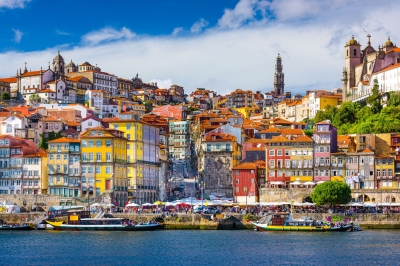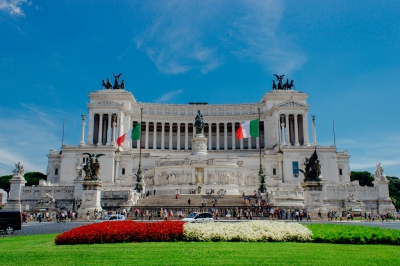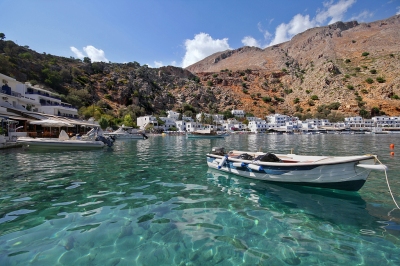
Lush green mountains in the north, gorgeous beaches in the south, rugged cliffs in the west and pristine villages alternating with modern cities – Portugal is filled with natural beauty and cultural treasures. Surrounded by golden plains, crystal clear mountain lakes and beautiful river valleys, the former seafaring country looks like a gigantic colourful garden: ancient trees, flowers and tropical fruits conjure up a fabulous atmosphere.
The picturesque Algarve in the southwest forms a contrast to the bizarre landscape. The “land of the setting sun” enriches Portugal with dream beaches along more than two hundred kilometres of coastline. Not to forget the capital Lisbon, which with its unique location is one of the most beautiful cities in Europe. Portugal is by no means an appendage of its neighbour Spain, but has its very own character and is rightly regarded as the “pearl of the Atlantic”.
Below we present the most exciting tours, the most beautiful attractions and the best sights in Portugal.
1. Lisbon
The white city stretches from the wide bay of the Tejo up to the steep hills – a dreamlike topographical situation. The unique light, which falls into the winding alleys of the old town, gives Lisbon its special character. Here history hangs on the walls – every step is rewarded with beauty. Events over 20 centuries lend the old seafaring town its irresistible charm.
Experience magnificent palaces, magnificent gardens and masterpieces of Portuguese architecture – such as the monastery complex in the suburb of BelĂ©m. Sensational views open up from the high-lying districts. Countless steps connect the upper and lower town. The heart beats faster in the narrow streets – soon you reach the Miradouro Santa Catarina; it forms a magical vantage point on the red roofs and the blue Tejo. Lisbon captivates with a rich culture and breathtaking monuments.
2. postage
On the right bank of the Douro, from where the old town rises up in steep terraces, lies the old merchant town of Porto. It was once the most important port city in historic Portugal. This is where the ships left to conquer the New World. In the old town, which is still partly connected by ramparts, the harbour town preserves its architectural history. Countless sights such as churches, cathedrals, bishops’ palaces and monasteries determine the cityscape.
Porto presents itself as a kind of architectural style whose spectrum ranges from the Middle Ages to the early 20th century. The Ponto de Dom Luis I, completed in 1885, spans the river. The bridge extends as far as Vila Nova de Gaia, the seat of the port wineries. Porto is not the city of individual buildings. Rather, the place explains itself as a chaotic total work of art and is therefore UNESCO World Heritage Site.
3. Évora
The pearl of the Alentejo lies in the south of the Algarve. The charming village is still almost completely surrounded by old walls, the townscape is characterised by alleys and squares with arcades. Évora, already an important city in Roman and Moorish times, has been a UNESCO World Heritage Site since 1986. On a hill in the historic landscape of the Alentejo, the market and trading centre developed into the Portuguese centre of humanism and at times served as a royal residence.
Among the extraordinary sights is the Diana Temple, built around 200 AD, with a fascinating and at the same time oppressive history. The Praça do Giraldo square forms the heart of the city and with its countless cafés, boutiques and terraces invites you to linger. Not far from the charming square is an impressive Renaissance fountain with eight well tubes and the stately church Igreja de Santo Antâo.
4. Sintra
Between Lisbon and the sea coast, a grandiose landscape garden was formed on the slopes of the Serra de Sintra granite mountain range in ancient times. Here, northern zones and the Mediterranean flora merge into a harmonious unity. No wonder, then, that Sintra has been the summer residence of Portuguese kings for centuries. In the middle of the 19th century Ferdinand von Sachsen-Coburg-Gotha had the Castelo da Pena built.
The castle and gardens are beautiful examples of the rapturous spirit of Romanticism. No less enchanting is the small town with its colourful architecture. Extravagant buildings and a wealth of national monuments are evidence of an extensive history. A spectacular view of Sintra and the surrounding region can be enjoyed from the walls of the idyllic castle ruins of Castelo dos Mouros.
5. Praia da Marinha
Snorkeling, diving, bathing or just relaxing: In the beautiful bays of Praia da Marinha, surrounded by steep cliffs, water sports enthusiasts and bathers cavort. The beaches of the Lagoa region exert a magical attraction. A long staircase leads down to the beach. It is worth a short break beforehand to enjoy the breathtaking view over the magnificent beach. Bows, dolims, grottos – you can’t get enough.
In a picturesque setting, holidaymakers enjoy relaxing bathing days. However, the famous rock structure, which looks like the letter M, is impressive. From Praia da Marinha the boats go to the sea caves of the Algarve. Romantic sunsets are guaranteed. Praia da Marina is one of the most beautiful beaches in the world. Once you’ve been here, you become a repeat offender.
6. Peneda GerĂŞs
Far away from the rest of the world, the Peneda-GerĂŞs National Park is located in the far northwest of Portugal. While the western part of the protected area is mainly used for agriculture, the rocky eastern part is home to rare animals and plants. Here, human activities have been harmoniously integrated into nature.
Fields with blue-violet tones conjure up a unique atmosphere, streams and rivers fall into cascades, small wild horses run around freely – the landscape is enchanting. Far away from the beach and the hustle and bustle, this is a paradise for hikers and adventurers. The winding hiking routes, past milestones, bridges and stone walls, are enjoying increasing popularity.
7. faro
Faro forms the centre of the Algarve with a picturesque old town. Three entrances lead through the imposing Roman city wall. It gives the impression of entering another world. From the magnificent square Jardim Manuel Bivar you have a wonderful view of the lagoon Ria Formosa. Tip for a day trip: Tours into the beautiful national park start at the small harbour.
Saltwater lagoons and the Wadden Sea form the Ria Formosa National Park, which forms an important habitat for wildlife around the town. Ria Formosa’s unique location and varied landscape have made it one of Portugal’s seven natural wonders. A boat or kayak tour is recommended along the enchanting landscape.
8. Cabo da Roca
The Portuguese poet LuĂs de Camões summed up the westernmost part of the European continent in the following words: “Here…where the earth ends and the sea begins…”. The inscription of the quotation can be found on the side of a huge monument on this headland. Cabo da Roca is a rough, deserted landscape.
Here, where thunderous waves break against rugged rocks, people believed until the 15th century that they were at the end of the world. Today the most dramatic landscape in Portugal is revealed. When the sun slowly sets, the place unfolds all its magic – a magnificent play of colours reveals itself.
9. GuimarĂŁes
GuimarĂŁes is the cradle of Portugal. Located at the foot of the Serra de Santa Catarina, the city was the first capital of the Portuguese kingdom. Alfonso Henriques lived in the castle, above the beautiful old town. In the 12th century he declared his county Portucale, the land between Minho and Douro, a kingdom.
The city centre houses traditional houses, Gothic buildings and beautiful squares. Particularly worth seeing is the windowless fort on the castle hill in the north of the city. No less impressive is the Paco Ducal, a palace of the Dukes of Bragança built in the 15th century. The city has been a UNESCO World Heritage Site since 2001.
10. Ponte de Lima
In the green north of Portugal lies the dreamy little town of Ponte de Lima, named after the Gothic bridge over the Rio Lima, with magnificent patrician houses from the 16th century. Every 2nd Monday, the oldest (since 1125) and one of the largest markets in Portugal takes place on the river promenade.
The charming little town lures with a magical atmosphere. Not only the magnificent houses and palaces attract countless people. Ponte de Lima is the Portuguese part of the Way of St James. Here the pilgrims meet on their way to Santiago de Compostela.
More things to do and activities for your Portugal holiday
Best time to visit Portugal
We recommend the following months as best time to travel for exploring the attractions and acivities of Portugal:
April, May, June, July, August, September, and October
You can find more information about the weather, including all climate data, on our climate page for Portugal.

![Pimp My Tram (Very Quiet) [flickr.com] CC BY-SA
License Information available under 'Proof of Image Sources'](/wp-content/uploads/reiseziele/pimp-my-tram65069_preview.jpg)
![Surf Algarve (Tiago J. G. Fernandes) [flickr.com] CC BY
License Information available under 'Proof of Image Sources'](/wp-content/uploads/reiseziele/surf-algarve90834_preview.jpg)





